Trapani: Salt deserts, ornamental gardens and sinful temples
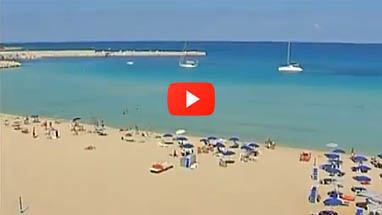
Trapani has become a popular destination in Sicily in recent years, mainly because the local airport is widely used by budget airlines rather than because of all the interesting things to do in Trapani!
One of the recommenations you will find a lot on this site is to visit Sicily for some winter sunshine, and so enjoy your holidays without hordes of tourists around you. Trapani is a partial exception to this, because some of the sights described below are definitely to be seen in summer, as they are all associated with the sea.
Our Trapani tour does recommend some places further afield, though, which will be very appealing to tourists from northern Europe looking for things to do in winter. Sicily is a lush green in winter so it does not rely exclusively on the lure of the beach! The first two of our recommendations are real insider tips which cannot be found in the mainstream tour guides.
Author
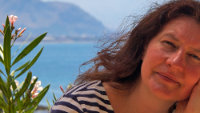
The information on this site comes from our Sicily expert Britta Bohn.
Britta has been dealing with daily life and life in Sicily for over 20 years.
Don't miss any of her tips! Subscribe to our free Newsletter:
An Invitation
Dear friends of Sicily, we invite you to join the Facebook Group "Trip-Tipp Sicily". Find answers to all your questions and discover exclusive tips for your trip to Sicily from those who have already made the journey and those who already know the island from the inside out:
Content
- Map - Sightseeing Tour of Trapani
- Monte Erice - Impressions
- Through the City Centre 90 Seconds
- Find your ideal holiday letting
Holidays lettings in Sicily
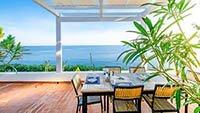
Are you looking for holiday lettings in Sicily but can't see the wood for the trees? We're not surprised, because the range of choices competing online is pretty confusing.
To make it simple, we present a small selection of quality holiday rentals, each one chosen for an unusual feature to make your holiday in Sicily extra special... more
Fashion made in Sicily

Sicilian fashion? Dolce & Gabbana?
Sure! But fashion designed and manufactured in Sicily is the real insider tip.
Like that of the Sicilian designer Filly Cusenza from Bagheria. She creates wearable art made of fabric, thread and buttons. Her trademark and label name is the fancy cartoon girl Filly Biz... more
The Essence of Sicily

Sightseeing Tour of Trapani
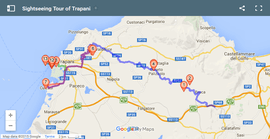
- From the motorway junction to Segesta and Erice.
- From Monte Erice to the Trapani Salt Museum.
- Route back from the Salt Museum.
- Route towards the old city.
- Parking at the harbour, the southern edge of the old city.
- Pedestrian zone - Via Torre Arsa - Corso Vitt. Emanuele.
- Bosco d'Arcudaci - Parking.
- Bosco d'Arcudaci - Panoramic view
- Buseto Palizzolo - Parking
- Buseto Palizzolo - City garden
- Monte Erice - Parking
- Monte Erice - Castle
- Salt Museum
- Bahnhof
- Casina delle Palme
- Fountain of Saturn
- Palazzo Cavarretta
- Fish Market
- Torre di Ligny
Reaching Trapani by car
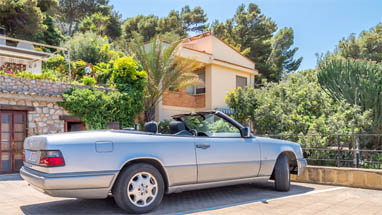
Trapani is connected to the motorway network in Sicily by the A29Dir. It ends just before the city and merges into the broad Raccordo Autostradale.
If you prefer to visit the sights in the wider area around Trapani (marker 1 to 6 in the map above), leave the A29Dir at the exit for Segesta (blue line).
If you prefer to start your holidays by visiting the Trapani salt marshes, follow the purple line at the end of Raccordo Autostradale to the Salt Museum. Please note that this is a one-way street so you have to take a different road for the return journey (red line).
If your goal is the sights of the old city, go along the green line to the harbour. You will find lots of parking spaces there, along the road Via Regina Elena. You can see them all if you switch the map into satellite fashion and zoom it around marker 9.
Reaching Trapani by Trenitalia
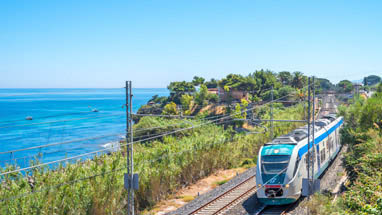
For those who love the combination of city and seaside, the old city of Trapani is fantastic. The downside to this is a less than fantastic connection to the Trenitalia network. For your holidays in Trapani, only the train connections to a few of the neighbouring cities such as Marsala are useful.
Because of Trapani Airport nearby, there are also some inter-city coaches which offer far better connections to a few cities further afield, including Palermo.
The first two attractions we describe in the Trapani area are not well connected by public transport and so only reachable with a rental car.
Bosco d'Arcudaci - The green lung of Trapani
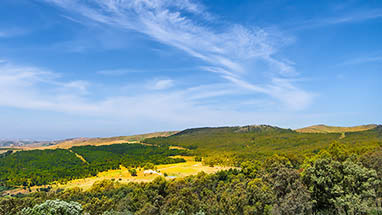 Pin it
Pin it The ancient Greeks and Romans laid the roots of our European culture, yet they also did a lot of uprooting as well – for with them began the large-scale deforestation of much of Europe.
Over the centuries the use of timber for ships, construction and fuel eventually led to a severe shortage of wood. In response to this, Sicily began a programme of replanting, which started in the 19th century but really gained momentum after the second world war.
Bosco d'Arcudaci (formerly Bosco Scorace) is one of the success stories of the reforestation programme. It has become the green lung of Trapani and in some areas it is so well-established and dense that visitors can hardly believe how young the forest actually is.
Rare animals and plants have found a safe habitat again, and are flourishing in the forest. There are various types of rare funghi. One species that has gone full circle is Caesar's mushroom, which was endangered but was fortunately able to reproduce in great quantities in the Bosco d'Arcudaci. This mushroom is so tasty that the ancient Romans called it the "Food of the Gods" and unfortunately this has led people to pick it so much that it has become an endangered species again, and is on the red list.
It is lucky that the people of Sicily are working so hard to restore and protect their forests.
The City Garden of Buseto Palizzolo (Villa Comunale)
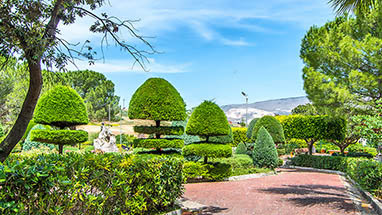 Pin it
Pin it The small town Buseto Palizzolo on the outskirts of Trapani is such a well-hidden secret that even many Sicilians do not know of it, and those who do are often unaware of the horticultural gem that is hidden here.
It was the brainchild of the architect Sebastiano Maltese. In the 1970s and 1980s he created a topiary garden in the city park of Buseto Palizzolo, in the fine old tradition of Italian formal gardens.
A walk around the garden is one of the most relaxing things to do in the Trapani area, yet it also fires the imagination. One of the attractions of this town park is a cedar, called the "Witch Tree" because of the shape of its branches. A line of cypress trees, which seem to reach out and offer embraces, is called the "Avenue of the Lovers". Next to this there is a weeping willow in which a woman’s tears can be seen.
Tears are also the theme of the central monument in the garden, which commemorates the victims of the two world wars. The Villa Comunale (the Italian term for town park) is the pride of the citizens of Buseto Palizzolo and a truly rewarding insiders' tip for holiday makers in Sicily.
Monte Erice - Impressions
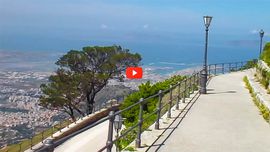
Monte Erice - From Temples of Sin to Theoretical Physics
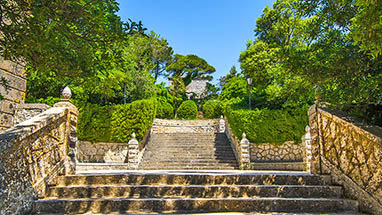 Pin it
Pin it Monte Erice on the outskirts of Trapani has always been a magical attraction for Sicilians and holiday-makers alike. The high-altitude town is often above the cloud level. If you are looking for things to do in the environs of Trapani, a trip to Erice is not to be missed.
Legend has it that the city was founded by King Eryx of Sicily, a son of Aphrodite the Goddess of love, and so Eryx was the original name of the city. There was already a temple on Monte Erice from Carthaginian times, dedicated to Astarte, a Middle Eastern goddess of female sexuality and war. The Greeks adopted this goddess, renamed her Aphrodite, and softened her into a goddess of beauty and love. The Romans in turn renamed her Venus
According to some controversial historians, this temple of Aphrodite was one in which prostitutes offered their services to temple visitors as a way of worshipping the goddess of love. There are various ancient written sources about temple prostitution, yet they always describe the practice as taking place in a foreign country and culture, not their own, and the writers always express their shock and outrage. This makes the whole custom seem far more likely to be an invention used as negative propaganda, rather than historical truth. Nonetheless, allegations have been made about the temple of Erice which give it a rather racy reputation.
Today, Monte Erice is a small district of the village of Erice, which has just a few hundred inhabitants. During the holidays, thousands of Sicilian visitors join them. They usually come for a day, by cable car or by bus from Trapani. They are lured by the attractions of a very well preserved medieval town and the breathtaking views of the mountains and the sea. From up in Erice, the salt pools of Trapani sparkle in beautiful shades of blues and greens.
The Ettore Majorana Foundation and Centre for Scientific Culture originally organised the Monte Erice Summer School of Theoretical Physics, and it now offers year-round courses for almost all scientific disciplines. Erice, therefore, is sometimes dubbed the "City of Science" (the "Città della Scienza" in Italian).
The organisation was named after Ettore Majorana a very promising Sicilian physicist who might have become another Archimedes (who was also Sicilian) or the Galileo of the 20th Century, had he not died prematurely at just 32 years of age.
- TripAdvisor reviews of Erice.
A Bird's-Eye View of the Salt Marshes
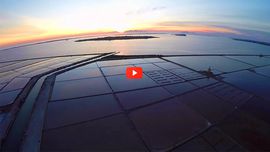
The Museum of Salt
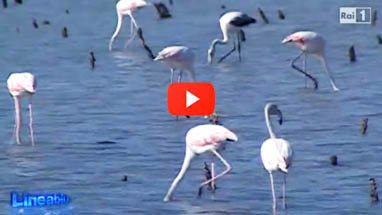
Now that salt is a cheap, mass-produced product, we easily forget it was once called "white gold" for its rarity and value. Not only does it render any food tasty, it is a vital nutrient and death is the inevitable consequence of a salt deficiency. We are so used to being warned not to eat too much salt nowadays that it may be hard to imagine how life in the past involved a constant effort to obtain enough of it. It was given for centuries as part of the wages for soldiers to ensure their good health, and the word "salary" derives from this.
In many cultures salt even took on magical properties. In Sicily, as in many parts of the world, it is still widely used to ward off the harmful forces of the evil eye. Sicilians scatter salt on the ground to protect themselves from the evil eye, and believe salt given as a gift brings good luck.
Salt has been very cheap since the mining of rock salt was industrialised in the 19th century. Until then, only deposits near the surface could be extracted, at great expense. The other way to produce salt was to extract it from the sea through evaporation, but this was only possible under very specific conditions. The coast had to be flat with a large expanse of very shallow sea spreading out from the coastline. The sun had to shine continuously for weeks in summer.
Trapani satisfies all these conditions perfectly. If you click "sat" at the top of the map, you will see the vast salt marshes which made Trapani one of Sicily's richest cities in the past.
Even when conditions are perfect, the production of sea salt is still laborious, complex and time consuming. Nowadays, sea salt production in Trapani is just a niche business for high-end food shops, and most salt production is industrialised, but the Museum of Salt shows every detail of the picturesque and ingenious production methods used in the past. It is probably one of the most unusual and interesting things to do on holiday in Sicily!
Meanwhile, the beautiful Trapani salt marshes have become a protected wildlife haven, offering a paradise for flamingoes and an extraordinary attraction for tourists to Sicily.
- Opening times and admission prices of the Museum of Salt.
- TripAdvisor reviews of the Museum of Salt.
Through the City Centre in 90 Seconds
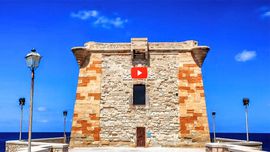
Casina delle Palme
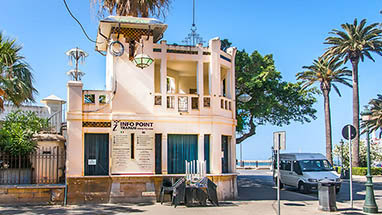 Pin it
Pin it The Casina delle Palme is an iconic Art Nouveau building in Trapani, which nowadays houses the Tourist information office and a small open air theatre.
Trapani is full of Art Nouveau architectural gems, all designed by local architect Francesco La Grassa. He was born and raised in Trapani at the end of the 19th century, the son of two local artists.
He rapidly became a highly successful architect and lived out his adult life based in Rome, yet he filled Trapani with his beautiful designs. He was one of the leading lights of the Italian Art Nouveau movement, and in Trapani you will feel his artistic presence at every turn.
The Fountain of Saturn
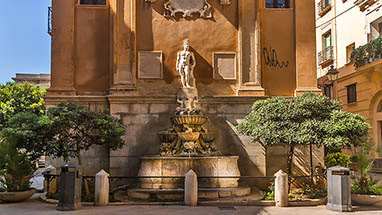 Pin it
Pin it When planning things to do in Trapani, a visit to the Fountain of Saturn is not to be missed.
The ancient citizens of Trapani always had plenty of water around them, yet it was salty sea water, and fresh water was in very short supply. Once salt production had made certain families of Trapani rich in the 14th century, they could afford to commision an aqueduct to carry fresh spring water from the mountains down to a fountain in the city centre. This original fountain was built in 1342.
It was dedicated to the Ancient Roman god Saturn, the patron of Trapani. Saturn was the father of the Roman gods, the deity of time and the universe. The name Trapani derives from Drepanon, the Greek word for sickle which was the favourite tool of Saturn, or Kronos as he was known to the Greeks. Legend has it that Saturn dropped his sickle into the sea by accident, and it became the peninsula of Trapani, upon which the town was founded. In this way Saturn became the patron deity of the city.
The fountain you see today was a rebuild, made in 1603 after the original fountain had dried up as a result of bad plumbing. This Renaissance fountain, adorned with a new statue of Saturn, is a stunning attraction for tourists and of great historical interest.
The Pedestrianised Zone and Palazzo Cavarretta
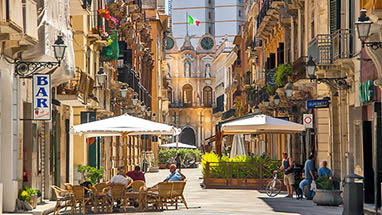 Pin it
Pin it The city of Trapani lies to the north of the salt marshes, and the focal point of the town for holiday makers is the western promontory. This is the home of the old city, with a central pedestrianised zone running along Corso Vittorio Emanuele and Via Torre Arsa which makes Trapani idyllic for summer holidays in Sicily.
Pedestrianised zones are fairly unusual in Sicily. They are difficult to establish in most of the cities because of the narrow medieval streets. The pedestrianised zone of Trapani is therefore a rare delight, along which you can enjoy a walk in the sun heading north to the beaches, or south past the historic town centre and the main harbour.
Palazzo Cavaretta, which houses the council offices, is one of the main landmarks of the old town and a beautiful attraction for tourists. The Palace has always been the seat of power in Trapani and was called The Senate House (Casa Del Senato) for a long time. It is nowadays named Palazzo Cavaretta after Giacomo Cavaretta, born to an aristocratic Sicilian family in the 17th century. He became an admiral of an order of knights founded during the Crusades, and later donated money for the restoration of the building, which has been named after him ever since.
During the following three centuries, additional restorations and embellishments have been made. The distinctive clock, for example, was added in the 19th century.
Fish Market

Salt is not the only resource that the sea offers to the people of Trapani. Fishing has always been another important local trade, and visiting the fish market is one of the many entertaining things for visitors to do in Trapani as it is still very lively. If you stay in self-catering accomodation, you can spend your holidays in Sicily eating organic fish so fresh it will often still be alive when you buy it.
The market is an important meeting point for locals as well as the site for cultural events during the year. One example of these events is the Street Food Festival. Our video to the right shows the festival held in 2010.
The old fish market is also a very popular subject for photographers, with its interesting shape and the intense blue backdrop of the Mediterranean sea and blue sky.
Less well-known but just as aesthetically appealing as the fish market, a nearby fountain takes the form of Aphrodite, the ancient Greek goddess of love and eroticism. This is the only fountain in Sicily made of cast iron – not a very erotic fact but possibly interesting to metallurgists!
- TripAdvisor reviews of the Street Food Festival.
Torre di Ligny
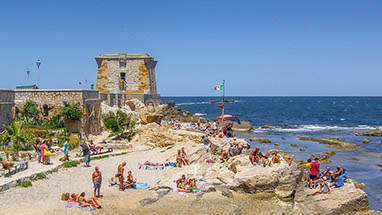 Pin it
Pin it Trapani was not only a rich city in historical times but, because of its location, of great strategic interest to invaders and defenders of Sicily. The Torre de Ligny was constructed as a defensive tower on the most Western tip of the island of Sicily, at the end of the peninsula of Trapani.
Although it was built in the 17th century, it was even used as recently as the Second World War as a base for anti-aircraft guns.
Whilst the Torre de Ligny is now a museum, Trapani's location means it is still of importance in military terms. Trapani's military airport, Birgi, was used as one of the bases for the air strikes against Libya during the uprising against Colonel Ghadaffi in 2011.